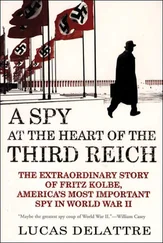Yet the worries were growing anew. In any clandestine operation, snags signal health and their absence should be profoundly troubling. The new CIA director, General Walter Bedell ‘Beetle’ Smith became convinced in 1951 that the lavishly financed covert operations against the communist bloc were in urgent need of scrutiny. He charged an old friend, General Lucian Truscott, to re-examine the whole programme. 27In early 1952, having inspected the training facilities, Truscott was horrified, particularly at the links to the heavily penetrated émigré organisations. An assistant, Tom Polgar, noted that Hitler’s 270 divisions had failed to topple Soviet power. How were a ragtag army of lightly armed guerrillas supposed to do any better? All their missions were proving, he scoffed, was the law of gravity. Drop agents out of aeroplanes and they would fall to the ground.
The American spymasters were unmoved. Rositzke thought that the scale of the operation must be causing nightmares in the Soviet leadership: even if they mopped up most of the agents, in a totalitarian system countering the slightest risk of subversion would consume huge resources. ‘Those in the Kremlin must be scared shitless,’ he said. [54] bb A CIA officer called David Murphy responded in a similar vein. ‘Even if they don’t send back good intelligence, we’re causing the Russians a lot of headaches.’
Caution was out of fashion and money was plentiful. [55] bc The Mutual Security Act allocated $100m to fund anti-Soviet guerrilla warfare.
The Baltic operations seemed at least in terms of volume to be the most promising. General Eisenhower himself visited the Baltic agents to assure them of his support. The operation continued, with parachute drops supplementing the midnight naval excursions favoured by SIS. A new American case officer, Paul Hartman, took charge, telling his trainees to ignore ‘nationalist rubbish’ and concentrate on real spying. Three of his agents parachuted into Latvia on 30 August 1952, with the promise of a $15,000 bonus if they returned safely. Two were caught; one committed suicide, the second surrendered. The third [56] bd Nikolai Balodis.
could have reported the truth: the partisans were defeated and the KGB in full control. Unfortunately, he proved to be an inadequate spy. He tracked down an old girlfriend and spent his operational funds on entertaining her. When he was picked up during a routine document check, the KGB determined that he had not transmitted any substantial intelligence. Armed with his codes and radio, it was able to spin the Red Web to include the Americans too.
Increasing political pressure heightened the chances of failure. John Foster Dulles, soon to become secretary of state, had denounced mere containment of communism as ‘negative, futile and immoral’; it consigned ‘countless human beings to despotism and godless terrorism’ and enabled the Soviets to ‘forge their captives into a weapon of our destruction’. Over at the CIA his brother Allen called for a ‘spiritual crusade’ for the liberation of Eastern Europe. As Tom Bower notes in Red Web :
At the very moment when the overwhelming majority of the CIA’s and SIS’s covert operations in Russia and the satellite countries was proving disastrous, the politicians were clamouring for more. 28
The efforts were producing no usable intelligence and showed no sign of destabilising Soviet rule. The best agents were dead, such as Lukša, betrayed and killed in 1951. [57] be An American-trained Lithuanian, Jonas Kukauskas, was captured soon after being parachuted into Lithuania in April. Faced with torture, he agreed to betray his leader, whose grave has never been found.
Soviet propagandists were regularly publishing gleeful exposés of captured agents, with details of their training and missions. Meanwhile SIS was reeling from the news that two British diplomats, Guy Burgess and Donald Maclean, had been unmasked as Soviet spies. The case against Philby was unproven, but the CIA had demanded his recall from Washington. It would have been a good time to pull back and submit all operations involving the Soviet Union, émigrés and partisans to cold, clear-headed scrutiny. But Carr and his colleagues pressed on.
betray his leader, whose grave has never been found. Soviet propagandists were regularly publishing gleeful exposés of captured agents, with details of their training and missions. Meanwhile SIS was reeling from the news that two British diplomats, Guy Burgess and Donald Maclean, had been unmasked as Soviet spies. The case against Philby was unproven, but the CIA had demanded his recall from Washington. It would have been a good time to pull back and submit all operations involving the Soviet Union, émigrés and partisans to cold, clear-headed scrutiny. But Carr and his colleagues pressed on.
It also would have been tempting for the KGB to use the bogus networks to plant disinformation – perhaps to scare the West into wasting resources, or even to give phoney reassurance about the benign intentions of the Soviet leadership. But the KGB aim was narrower and deeper: first to distract and then to penetrate SIS and the CIA. The next stage was to send a seasoned KGB officer to the West. The choice was a man named Jānis Ērglis who had long fought the partisans in the forests of Latvia, and was now tasked with impersonating one. He ‘escaped’ to Sweden, convinced the intelligence service there of his bona fides, and then moved to Germany where, after feigning reluctance, he was recruited by SIS. After training he returned to Latvia, this time as leader of a group of four agents. Thus the KGB not only controlled the activities of the British agents; it was able to stage-manage them too. Flickers of discontent among the unfortunate genuine agents sent to Latvia had no chance of reaching London.
Lukaševičs next arranged for misfortunes to befall two of the genuine London-trained agents. Instead of smelling a rat, SIS decided to send replacements, receiving another phoney partisan, a radio operator called ‘Edmundas’, as well as a fiery and effective fighter, [58] bf Ludis Upãns, cited in Bower as ‘Lodis’ Upans.
whose desire to kill communists had strained the patience of his hosts. The KGB then sent a heavyweight ‘ambassador’ from the phoney partisans to London, who solemnly negotiated a deal with SIS and the émigré authorities, dividing ministerial portfolios in a putative independent Latvia. He returned home with a colossal cache of money – around a million roubles. Lukaševičs was later to boast that a total of 3.5m roubles from the British taxpayer had financed his entire deception operation. Real agents, such as a brave young Latvian CIA man called Leonids Zariņš, paid the biggest price of these games. He was parachuted into Latvia alone on 14 May 1953. But the CIA shared details with SIS, which took no precautions to keep the information secret from others in the operation. Zariņš walked straight into a trap and perished in a Siberian prison camp. His family, who believed their son was working for Bell Telephone, was told that he had died in an air crash in Austria.
But the KGB was becoming a victim of its own success. London requested a sample of water from the Tobol River, near the site of the reactor that produced the Soviet Union’s plutonium. The idea that a partisan, with forged papers or none at all, could emerge from a forest bunker and cross and recross the Soviet Union successfully, via a tightly guarded nuclear installation, was so bizarre that only a spy chief could have conceived it. But the Soviet response was equally incompetent. Told to provide some radioactive water, KGB technicians (presumably poorly briefed) decided to show off. They produced ‘river water’ of such lethal radioactivity that it could only have been created actually inside the core of a reactor. Once that was analysed in London, it was finally clear that something was seriously amiss. America commissioned an independent investigation and ended its operation in 1954. Operation Jungle limped on for two more years. A final message to the partisans in 1956 read:
Читать дальше












